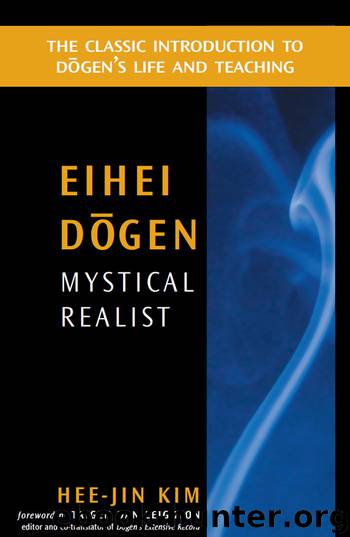Eihei Dogen: Mystical Realist by Hee-Jin Kim & Taigen Dan Leighton

Author:Hee-Jin Kim & Taigen Dan Leighton
Language: eng
Format: azw3
Tags: Philosophy
ISBN: 9780861713769
Publisher: Wisdom Publications
Published: 2000-01-01T00:00:00+00:00
Third, a Dharma-position does not come and go, or pass, or flow as the commonsense view of time would assume. This is a radical rejection of the flow of time, or the stream of consciousness, or any other conceptions of time based on the idea of continuity and duration. That is, time is absolutely discrete and discontinuous. This characteristic was primary to Dōgen’s thought.166 His thesis, however, was not based on any quantitative or atomistic consideration of time, that is a theoretical concern, but rather on qualitative and practical reflections on his existential and religious experiences of the present. As he probed the “reason of total exertion” (gūjin no ri), he could not help but come to the idea of the radical discontinuity of the present.
Though the expressions themselves of “abiding in the Dharma-position” and “the total exertion of a single thing” were by no means Dōgen’s own invention, the ideas themselves nevertheless bore the imprints of typical Dōgen-like mystical realism, as epitomized in Dōgen’s statement (the English translation of which hardly does justice to the spirit, eloquence and force of the original Japanese): “Obstruction hinders obstruction, thereby obstruction realizes itself (ge wa ge o sae, ge o miru); obstruction obstructs obstruction (ge wa ge o gesuru nari)—such is time.”167 As Dōgen explained immediately after this passage, “obstruction” (ge, a shortened expression of keige) was not used in the ordinary sense of the word, but in the sense of “self-obstruction” while abiding in a Dharma-position. A thing was obstructed by itself and nothing else; that is, it exerted itself in perfect freedom.168 Dōgen’s purport was to express the realistic aspect of thusness, which entailed neither a monistic nor a phenomenalistic reductionism. Accordingly, we might legitimately translate the above passage as: “Thusness thuses thusness, thereby thusness realizes itself …” Analogously, “a mountain mountain-s a mountain, thereby a mountain realizes itself …” and so on, in the manner of total exertion.169
So far I have tried to establish the necessary relationship between the idea of abiding in the Dharma-position and that of the realized now in Dōgen’s thought, for Dōgen declared: “Living vigorously in a Dharma-position—such is existence-time.”170 We can now fully comprehend the statement to which I referred earlier:
The deity with three heads and eight arms is yesterday’s time; the Buddha of one jō and six shaku is today’s time. But the truth of yesterday and today is [comparable to] that moment in which one climbs a mountain and looks around at tens of thousands of peaks at a glance. Time does not pass. The particular time of the deity [of yesterday] is also experienced precisely as my existence-time; though it appears to be far off, it is the realized now. The particular time of the magnificent Buddha [of today], too, is realized as nothing but my existence-time; seeming to be far away, it is the realized now.171
Download
This site does not store any files on its server. We only index and link to content provided by other sites. Please contact the content providers to delete copyright contents if any and email us, we'll remove relevant links or contents immediately.
The Way of Zen by Alan W. Watts(6292)
Ego Is the Enemy by Ryan Holiday(4963)
The Art of Happiness by The Dalai Lama(3851)
The Book of Joy by Dalai Lama(3704)
Why Buddhism is True by Robert Wright(3290)
Spark Joy by Marie Kondo(3089)
Shift into Freedom by Loch Kelly(3031)
Happiness by Matthieu Ricard(2888)
A Monk's Guide to a Clean House and Mind by Shoukei Matsumoto(2786)
The Lost Art of Good Conversation by Sakyong Mipham(2443)
The Meaning of the Library by unknow(2390)
The Third Eye by T. Lobsang Rampa(2174)
The Unfettered Mind: Writings from a Zen Master to a Master Swordsman by Takuan Soho(2160)
Red Shambhala by Andrei Znamenski(2073)
Anthology by T J(2047)
The Diamond Cutter by Geshe Michael Roach(1957)
Thoughts Without A Thinker: Psychotherapy from a Buddhist Perspective by Epstein Mark(1899)
Advice Not Given by Mark Epstein(1766)
Twilight of Idols and Anti-Christ by Friedrich Nietzsche(1764)
